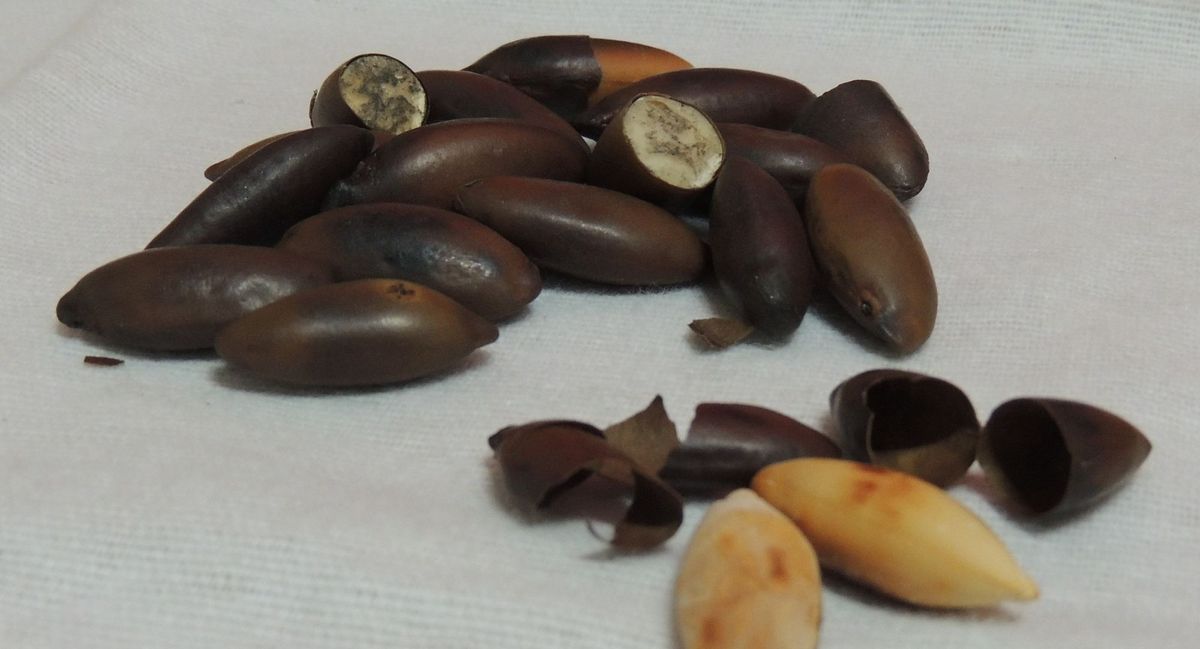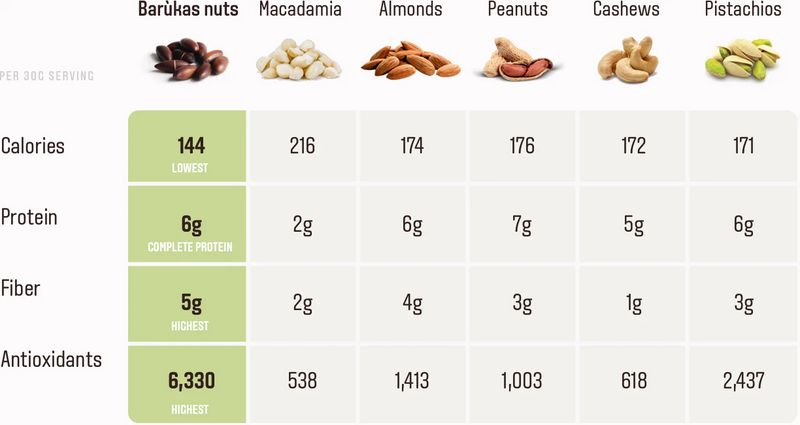Barùkas Nuts: Here's Why It's So Expensive
Emerging from Brazil, Baru nuts are gaining favor for their rich flavor and nutrition, yet their premium price of $25 per pound also reflects the historical clearing of Baruzeiro trees for agriculture, with recent initiatives now aiming to mitigate this damage.

Originating from Brazil, Baru nuts are gaining popularity for their enticing flavor and significant nutritional value.
Harvested from the "Cerrado," Brazil's savanna ecoregion, purchasing these nuts, priced at $25 per pound, supports local agriculture and ecological health.
Historically, many baruzeiro trees were cleared for timber, cattle farming, and other agricultural activities, impacting the local ecology and global climate.
Recent initiatives aim to restore the baruzeiro trees, mitigating past damages. Now, let's unravel the factors making Baru nuts a premium choice.
What is Baru Nuts?
Barùkas nuts, also known as baru nuts, come from the baruzeiro tree (Dipteryx alata Vog.), which is native to the Cerrado region - a tropical savannah biome covering parts of Brazil, Paraguay, and Bolivia.
Baru nuts necessitates a growth period of seven to eight years before it begins yielding these nutrient-rich nuts. Being a member of the legume family, baru nuts are encased in a sturdy exterior shell.
The nuts are a newly discovered superfood, celebrated for their unique nutritional profile. They offer 25% fewer fat calories, 6 grams of protein per serving with all essential amino acids, three times more antioxidants, more fiber, and a high content of micronutrients like magnesium compared to other nuts.
History and Origin
The baruzeiro tree has long been a part of the Cerrado region, which is known for its unique biodiversity but has been significantly impacted by deforestation.
The name "Cerrado" comes from the Spanish word "closed", referring to its historically remote and undeveloped nature.
However, since the 1990s, deforestation for soybeans, corn, and cattle farms has increasingly ravaged this region.
The baruzeiro tree's ability to withstand the harsh climatic conditions of the Cerrado is notable, and the nuts it produces have recently gained attention for their nutritional benefits and potential to support sustainable agricultural practices in the region.
Why Baru Nuts Are So Expensive?
The higher cost of Barùkas nuts can be attributed to several factors:
Limited Harvesting Window
The baruzeiro trees, native to the Cerrado, a vast tropical savannah biome spanning around 500 million acres across Brazil and parts of Paraguay and Bolivia, bear fruits only once a year.
The harvesting window is notably narrow, spanning just 8-12 weeks between August and September each year, before seasonal rains commence and the fruits start to germinate.
This limited timeframe for collection contributes to the nuts' exclusivity and cost.
Manual Collection
The collection of Barùkas nuts is a manual process, predominantly carried out by local communities and indigenous people within the Cerrado region.
The nuts are encased in hard fruits that fall from the baruzeiro trees, which necessitates foragers to physically collect the nuts from the ground.
This process is labor-intensive as it requires a significant amount of human effort to cover the vast areas where the trees are dispersed.
Moreover, the process of separating the nut from the hard fruit shell also requires manual labor.
The engagement of local cooperatives, and the involvement of a large number of locals (10,000 to 20,000) in foraging activities, underlines the labor-centric nature of Barùkas nut collection.
Processing
Once harvested, the Barùkas nuts undergo processing to be market-ready. They are transported to facilities where they are separated from the hard fruit shell.
The nuts are then roasted, a process that not only enhances their flavor but also preserves their nutritional value.
The roasting is crucial to maintain the nuts' profile rich in antioxidants, proteins, and other essential nutrients, making them appealing to health-conscious consumers.
This stage of processing requires facilities, equipment, and adherence to quality standards to ensure the final product retains its marketed health benefits and taste.
The costs associated with processing, including roasting and packaging, contribute to the overall price of Barùkas nuts in the market
Baru Nut Trees Thrive Only in Specific Regions
Barùkas nuts hail from the baruzeiro tree, native to South America's Cerrado region, notably in Brazil, extending into Paraguay and Bolivia.
The Cerrado's harsh drought conditions have shaped the baruzeiro trees to be drought-resistant, thriving in this unique ecological setting with specific soil composition and climate.
They rely solely on the region's rainfall, growing sustainably in one of the world's most biodiverse regions. The precise conditions of the Cerrado are hard to replicate, making the cultivation of baruzeiro trees challenging in other regions.
Superfood Status

Barùkas nuts, with a protein content of 26.3% and lipids at 33.3%, are nutritional dynamos housing minerals like calcium, phosphorus, and manganese.
Remarkably, they have the lowest 144 calories and the highest antioxidant level among nuts, with a 6,330 ORAC in a 30g serving.
The added benefits from the fruit's pulp and the traditional medicinal uses of the tree's parts further cement its superfood status.
This nutritional richness and versatility contribute to the higher price point of Barùkas nuts, aligning them with other esteemed superfoods.
Sustainable Harvesting and Supply Chain of Barùkas Nuts
Barùkas Inc. intertwines community engagement with ecological sustainability in the harvesting of Barùkas nuts.
Through partnerships with local cooperatives, they've mobilized 10,000 to 20,000 locals for foraging, purchasing all harvested fruits at a fixed rate per kilogram, while reserving one-third for natural regeneration, promoting sustainable harvesting and fair wages.
This ethos of sustainability permeates their supply chain, targeting social equity and economic growth in the Cerrado region. The procurement of Barùkas nuts aids reforestation endeavors and combats local deforestation.
The nuts' growing popularity helps deter land clearance for cattle, establishing a mutually beneficial cycle for the environment and indigenous communities.
This initiative amplifies job opportunities, supports fair trade practices, and positions Barùkas nuts as a symbol of ecological conservation and social responsibility.
Flavor Profile
Barùkas nuts blend the flavors of peanuts and almonds with a hint of coffee-like bitterness.
Their texture starts with a firm crunch akin to almonds, transitioning to a smooth, creamy consistency reminiscent of peanuts, making every bite a delightful blend of taste and texture.
Barùkas Nuts Other Health Benefits
Barùkas nuts are a nutritional powerhouse, aiding in reducing abdominal fat and boosting good HDL cholesterol.
They harbor healthy fats, particularly unsaturated ones, promoting heart health. With a rich antioxidant profile, they combat oxidative stress and inflammation.
They provide essential minerals like calcium, phosphorus, and manganese for bone health and energy production, alongside dietary fiber aiding digestion and blood sugar stability.
Despite their nutritional richness, their lower caloric density compared to other nuts makes them a wise choice for calorie-conscious individuals.
The Vitamin E content further enhances skin health and acts as an antioxidant, summarizing Baru nuts as a healthful choice.
In Conclusion
Baru nuts, native to Brazil's Cerrado biome, are a boon for both personal health and local agriculture. Thriving on just rainwater, they require no artificial irrigation or fertilizers, standing as a non-GMO and gluten-free powerhouse.
With antioxidants surpassing other nuts, and at $25 per pound, your purchase extends beyond the palate, directly supporting sustainable agriculture and aiding in preserving Brazil's precious ecosystems.
The premium cost reflects not just quality, but an investment in environmental and community well-being.


